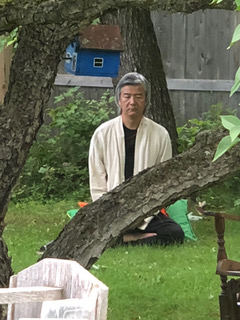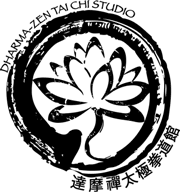
Master Danny Lai
Danny Lai is from Taichung, Taiwan. He has studied many kinds of martial arts, chi kung (hard and soft), meditation, and Eastern philosophy since 1996. He’s certified by the Taichung Kuo Shu (Kung Fu) Federation. He has a black belt in Tae Kwon Do. He currently lives and teaches in Calgary, Alberta, Canada.
Danny’s Tae Kwon Do teacher is Master Tsai, an 10th degree Tae Kwon Do blackbelt.
Danny studied Tai Chi from Master Chang Ru Ching. He traces his martial arts lineage directly back to Master Wang Shu Jin. Master Chang taught me Chen Pan Ling (99) Style Tai Chi, Ba Gua and Hsing-Yi.
Danny has created his own form of Chi Kung, called ‘Yi Jin Jing’ or ‘Change Tendon Sutra’. It is a combination of several different Shaolin chi kung forms.
He teaches (and practices) meditation: Taoist standing meditation, zen sitting meditation and Chinese turtle meditation.
His students often discuss Eastern philosophy with him.
Danny has taught in Taiwan, Canada and the US. In Canada, he teaches from his home studio and has taught at or for the City of Calgary, Mount Royal University, Cross River Wilderness Centre, Jacobs Canada Inc., Imperial Oil Let. and SAIT Polytechnic.
Interview with Danny Lai:
Look deep into a park corner and you may see a senior citizen practicing Tai Chi Ch’uan. With its distinctive soft and slow movements you may be led to believe that this exercise is exclusively for the silver-haired race, practiced to keep them in good health. This is a common first impression. “The layman watches the fun; the expert looks at the way.”
To those who have practiced Tai Chi Ch’uan, another axiom rings true “To practice quickly is easy, to practice slowly is difficult.” Slow Tai Chi Ch’uan becomes a profound experience. The practitioner is striving to let her body slowly follow a certain path, smoothly shifting her center of gravity, organizing and integrating all her limbs as they extend and withdraw to acquire the “Song(Loose) Jìng(Calm) ZìRán(Nature)” of the Art. It is not an easy thing.
The first difficulty to overcome is how to make the body completely loose and soft.
First, we have to overcome involuntary muscle stiffness and tension in our limbs and body while we maintain a stance. In addition, we have to put aside the powerful idea that to make a movement strong we need to use brute force. The nature of Tai Chi Ch’uan is to use the natural forces of body mechanics.
The second challenge is achieving mental relaxation.
Observing this era, you may think that efficiency has been elevated to the supreme attribute. Everyone is trying to increase the speed they do things. You should triumph over all your competitors. Wasted time is squander life. If you stop moving forward that only means you fall behind. Slow movements are an unforgiveable defect. Everyone is like a racing vehicles travelling on a no-speed-limit highway in a car configured with just an accelerator. Without a brake, the only struggling is to continue moving forward. Even with brakes, no one is willing to use it. Spend enough time driving this way and people forget how to break and decelerate.
Learning the spirit of “Song(Loose) Jìng(Calm)” can help people adjust their rhythm of life; to rediscover their braking capability. Then, when you drive into a curve, you can gauge the right moment to decelerate in accordance to the state of roads. Only then can you smoothly stay to the road you have chosen rather than exit in a panic.
People experiencing mental strain register brain wave vibration frequencies around 13-30Hz. This is the fastest wave form, commonly known as tense brain waves and Beta waves. People describe this consciousness as blindly chaotic. Their spirit is unable to concentrate. Their anxiety causes them to miss important clues pointing to a favorable outcome.
Simply taking several deep slow breaths and consciously trying to relax body and mind changes brain waves to a 8-13Hz vibration frequency. These stablest of brain waves are usually known as relaxed, alpha, or creative brain waves wave. This state of calm concentration allows a bridge to form between the conscious and the subconscious, igniting creative vision.
Just like an “old monk sitting in contemplation”, this focused train of thought is helpful in dismissing distracting thoughts and organizing chaotic information. It becomes easier to see slight changes then progress to understanding what came before and happened after. Seeing the patterns supports detecting the real cause of problem. Then a more correct decision can be made.
After many years of martial arts training I have realized that the highest level of martial arts training first emphasizes balance and relaxation. For a clear mind maintaining elasticity is the key. Through Tai Chi Ch’uan practice, achieving personal “Song(Loose)Jìng(Calm) ZìRán(Nature)” in both body and spirit can raise one’s thoughts to a level of pure brightness and agility.
Perhaps you are looking for something that will help you have less chaos and anxiety? Something that will help you control changes rather than react to unfavorable circumstances with unprepared skills, or only discovering new skills when under stress or upon the pain of death? Perhaps you are feeling you are energetically out of balance? It may be worth considering learning the loose body and calm mind or “Song(Loose)Jìng(Calm) ZìRán(Nature)” of Tai Chi Ch’uan.

Knowledge Into Practice
I know that every year, at the start of the New Year, people make new resolutions. Some are people who want to stay in shape and have read about Tai Chi or Chi Kung as being good for your health, so they start Tai Chi classes. But only a few people persevere with the training. Most people break their resolution after only three months.
I often hear the sentence “Education can change life.” I think it means that in poor countries, if you let children get education, their life improves. They can use the knowledge to get a good job when they getting older. In poor countries where many don’t have the basic necessities of life, I believe that education can help. But in advanced countries when we talk about “a good healthy life” I sometimes doubt that education can do this.
Here is an example. I knew a man in his early 50s, with two Masters degrees and a good job with very good pay, but not a good life style. His was overweight and diabetic. He knew T’ai Chi and Chi Kung exercise were good for his health so I let him join my tai chi classes for free. But every time we finished warm-up and stretching, approximately 1/4 way through the class, he stopped and said he had enough exercise. He also knew that if you have diabetes you have to control your diet. Yet he still ate junk food all the time, sometimes even eating a whole bowl full ice cream. If I reminded him that this was not good for him he will say he knows and then argue with me.
My wife is a nurse. One day I went with her to a staff party and I saw some of her colleagues talking together and start smoking! These things just make me to think “Is education or knowledge really enough to change one’s life?”
I think, paired with knowledge, the most important thing to do to have a good healthy life is to actually use that knowledge. You need to do it, not just know it.
There is a Buddhist story that goes like this: Molokaz was a disciple who followed Sakyamuni Buddha for a while. But he had some questions bothering him. One day he got a chance walk outside with Buddha.
From his face Buddha knew Molokaz’s heart was not at peace so he ask him, “Do you have any questions bothering you Molokaz?” Molokaz said, “Yes, Buddha. Why do you always not want to answer my questions? Please answer my questions clearly today. I have been puzzling over them for a while now. If I can’t get the answer from you today I think I will leave. My questions are; Is this world limited or limitless? Are our body and spirit together or separate? After we die does our spirit continue to exist or not? After you, the Buddha, die will you still exist or not? These are all my questions. Please answer me Buddha.” “Molokaz, do these questions really bother your practice?” Buddha asked. “Let’s look over there. Do you see that body of a fallen deer? Now just imagine you are this deer and got shot from a hunter’s arrow. You got very seriously injured, but when a doctor came, ready to cure you, you stopped the doctor. You told the doctor “I want to know who shot me. How did this guy look like? I also would like to know what kind of bow and arrow he used. If I don’t get these answers I don’t want the cure.” And maybe before you got all the answer you died. So, Molokaz what is the most important thing to do? Should you let the doctor cure the injured as soon as possible? Isn’t that the most important thing to do? Now let’s deliberately look at our lives; birth, old age, illness, death and all the vexations of our lives in samsara. Aren’t these the most important problems for people to overcome? That is why I always teach people practical methods of practice. Even if you know all the answers to your questions it will only be knowledge. This kind of knowledge cannot help people get enlightenment. My job is to offer useful ways to help people release their life from suffering.” After Molokaz heard this from Buddha he knew what the right answer was to his questions.
I think everyone would like to have a life of quality. But what is the most important component? Having good health is. I read a report; over sixty-four percent Americans are overweight. When you are overweight your risk of developing diabetes, heart disease and other health problems goes up significantly. How can we keep our weight normal? We all know the answer: exercise and control your diet. But fewer people can do this than ever before.
In this information age most people can easily get information or knowledge from the Internet or television. But this also causes us new problems. We spend too much time in front of computer or TV and less time doing exercise. We also have too much information and trouble choosing just one course of action.
If you know Yoga, T’ai Chi, Chi Kungdoing any of these exercises can bring you a lot of benefits. But if you say; “I’m too busy now, I’ll start when I have more time” then you don’t really benefit; it’s just in your mind. The real benefits come with practice.
“A gentleman has three worries: Not yet being informed of a good thing, he worries until he knows. When he knows, he begins to worry that he has yet to learn it. When he has learn it, he begins to worry that he has yet to put it into practice.” —–A Chinese Maxim

